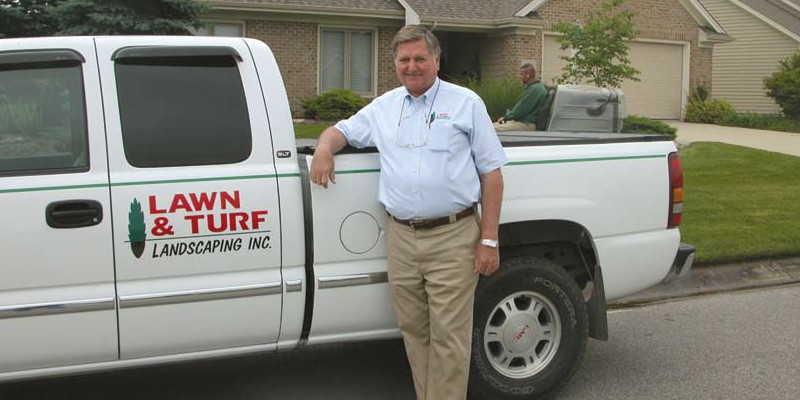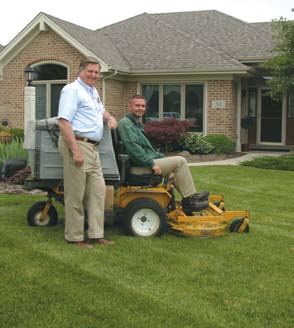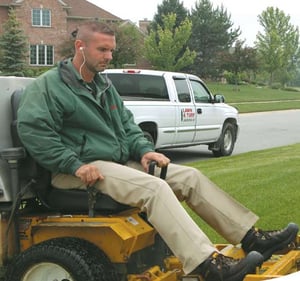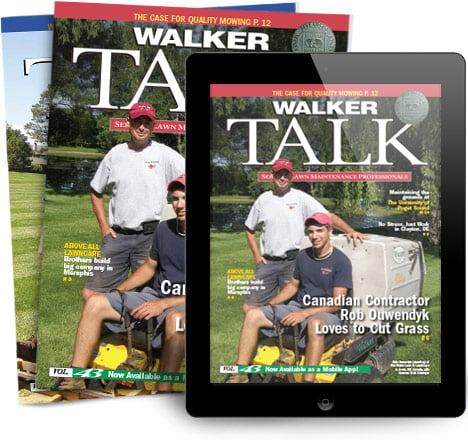After being in business 41 years, Erv Denig, a registered landscape architect, knows the people of Fort Wayne, Indiana, and they know him. In fact, prospective homeowners are so familiar with his work that many of them call him even before they buy a lot. Why? Because they understand that his company, Lawn & Turf Landscaping, Inc., has a knack of blending landscape design and architecture. Getting this landscape contractor and architect involved early on ensures that the property, the home and the landscape will connect in just the right way.
Denig has a resume to match these high expectations. He has been mentored by some of the most respected names in the landscape industry, and his company has a wealth of experience designing, building and maintaining a wide array of commercial and high-end residential properties. In his words he also has “the best equipment money can buy” and long-time employees who “know what is expected of them.” As if this isn’t reason enough to call Erv, consider this: He has an attitude. He has a strong work ethic and believes that building lasting relationships with customers, dealers and employees are fundamental to success and longevity in this industry. After four decades of proof, who would argue with him?

Lawn Turf runs three installation crews, three maintenance crews and two lawn care crews. The company provides a broad range of services, including hardscape and irrigation installation, and caters to commercial and residential customers who are full-service oriented. “Our goal has always been to give customers that ‘one call does it all service,’” Denig says. “Then, we strive to keep them forever.” A little reticent about putting a dollar amount on his business volume, he admits, however, that many of his full-service customers have more than 100,000 square feet of turf to maintain, and overall, his crews mow and maintain several million square feet of turf a week. By service mix, Lawn & Turf generates 50 percent of its revenue from design and installation, 40 percent from maintenance and 10 percent from lawn care. Snow removal alters the mix slightly, depending on the year.
Agrarian Roots
Raised on a family farm in Fort Wayne, Denig started mowing lawns at the tender age of 12 and continued doing so part-time until launching his business in 1965. He earned a bachelor’s and master’s degree in business from Ball State and later took several design courses at Purdue, all the time mowing lawns to earn his way. “I always wanted to be a landscape architect,” he recalls. “I even taught drafting at a junior high school while mowing 100 yards a week. I didn’t get married until I was 35. Back then, it was all about work.”
This contractor attributes his work ethic to his father, who was a tool and die maker, and his uncle, who ran the farm and taught him to operate and maintain equipment. “I guess most of us in this business like equipment,” he notes with a smile. “Our crews operate several Kubota, Walker and Wright Stander mowers. We have two large wheel loaders and several 16-foot snow blades, and that’s not even counting all the equipment we have for installation. If I were to put a figure on it, I would say we have at least a half million dollars worth of equipment.
“We were one of the first landscape contractors to introduce Walker Mowers to our area,” Denig continues. “I happened to see a contractor with two Walker Mowers. After watching them operate the mowers and talking with the Walker folks at a trade show, I decided to give the Walker Mowers a try. That was 20 years ago, and we’ve been using them ever since for our high-end properties where removing grass clippings is a requisite. Until I discovered Walker, I could never find a mower that was both durable and could catch grass.”
 By the time Lawn & Turf purchased its first Walker Mower, the company had been transformed from a two-person mowing operation into a full-service company. As Denig relates, it all started when a customer asked if he could replace a couple of bushes. He obliged, and it has been nonstop growth ever since.
By the time Lawn & Turf purchased its first Walker Mower, the company had been transformed from a two-person mowing operation into a full-service company. As Denig relates, it all started when a customer asked if he could replace a couple of bushes. He obliged, and it has been nonstop growth ever since.
“I always wanted to be big rather than small,” says Denig. “I started attending conferences and getting involved at the local and national level with associations. If there’s one thing more than any other that has contributed to our success, it’s been my willingness to network with other successful companies and bring in consultants to help us with growth issues. Being successful in this business is all about developing relationships with virtually anyone associated with your business.”
Over the years, Lawn & Turf made a successful foray designing and building athletic fields, and even consulted with the head Yankee groundskeeper on a ball diamond construction project. The company has also worked closely with Jack Nicklaus designing and building a golf course. Today, though, the highend residential and villaminium markets help fuel both the design/build and maintenance divisions.
Minium Mania
When asked to describe a villaminium, Denig points to a row of nicelooking homes adjacent to a high-end subdivision. He explains that developers often add low-maintenance homes to their properties. Appealing to retirees who don’t want to maintain their lawns and landscapes, the homes are ideally suited for Lawn & Turf. “We can provide all maintenance services, including mowing, trimming, and delivering lawn and tree care,” Denig relates. “While we’re in the neighborhood, we also strive to get the maintenance work from other homeowners in the subdivision.”
Either way—commercial or residential customers, property managers or homeowners—Lawn & Turf looks to sign up customers to multiyear contracts. “That’s the name of the game in maintenance today,” says Denig. “Companies need the security long-term contracts offer.
“I think the market is much more competitive and difficult now than it was when I started in business,” he goes on to say. “Competition can be fierce, especially in maintenance, and finding employees seems to be getting more difficult every year. Margins are shrinking, too. My advice to anyone just starting out is to build lasting relationships, find a niche, and make sure to buy equipment that matches that niche. For example, we run three different maintenance crews. Our large-property crew operates Kubota zero-turn riders equipped with 61- inch decks. Our 48-inch GHS Walker Mowers maintain high-end mid-size properties, and we use the Wright Standers on smaller, condominiumtype areas where we can’t get the Walkers and where we can leave the clippings behind.”
Having quality equipment is important, he adds. “Look around, we don’t have a snazzy new shop or a modern-looking office. We work out of the family farm and use the barn for our shop and the farmhouse for our office. We have dressed both up and have nice areas for our employees, but we put most of our money into equipment. Equipment makes us money, not the buildings. Furthermore, employees appreciate using top-of-the-line, reliable equipment.”
The facility is located on 20 acres of land, plenty of space for holding nursery stock and developing a compost site. The owner knows he is fortunate to have a place to dispose of clippings and the means to turn them into a revenue-producing product. On site, Denig’s crew handles clippings efficiently, too, employing a large truck vacuum to do the “heavy work.”
 “The vacuum works like a charm,” says Walker operator and foreman Will Hinen. “We just dump the clippings on the side of the road and then pick them up when we’ve finished maintaining the property. The approach is so much easier than using a pitch fork or handling a tarp.” He taps the side of his Walker Mower. “I don’t know what I like best about this machine. You cannot beat how it vacuums the clippings, but it’s also maneuverable, easy-to-operate, and I can trim from either side of the deck. Being able to hang the deck over the edge of flower beds dramatically reduces our trimming time. With a little out-front planning, I can even use the mower on our smaller properties.”
“The vacuum works like a charm,” says Walker operator and foreman Will Hinen. “We just dump the clippings on the side of the road and then pick them up when we’ve finished maintaining the property. The approach is so much easier than using a pitch fork or handling a tarp.” He taps the side of his Walker Mower. “I don’t know what I like best about this machine. You cannot beat how it vacuums the clippings, but it’s also maneuverable, easy-to-operate, and I can trim from either side of the deck. Being able to hang the deck over the edge of flower beds dramatically reduces our trimming time. With a little out-front planning, I can even use the mower on our smaller properties.”
Lawn & Turf currently has three Walker Mowers; two are a couple years old and a third is brand new. The company places most of its mowing equipment on a two-year replacement cycle, and soon, as much of it as possible will be powered by diesel engines.
“The diesels use less fuel, and in today’s environment, operators need to save money where they can,” Denig emphasizes. “Replacing our maintenance equipment every two years also keeps downtime to a minimum. If you’ve been in this business, you know that downtime is brutal. A lost day is lost revenue.”
Denig credits his local Walker dealer Taylor Rental and Kubota dealer More Farm Store for keeping his downtime to a minimum and providing great service. Again, it all comes back to relationships, Denig reemphasizes. Maybe there was a time when landscape contractors could be cavalier in their approach to doing business, when they could have a cursory relationship with customers and suppliers. Not anymore, says this veteran. When Denig’s customers want exemplary landscaping, they call him. Don’t think for a moment, though, that Erv doesn’t have a call list of his own and people he can turn to when he needs products, services or just some solid advice.




 Site Search
Site Search



